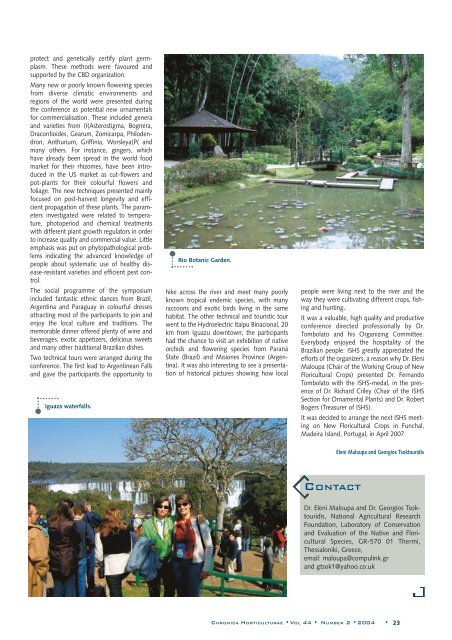Number 2 - 2004 - Acta Horticulturae
Number 2 - 2004 - Acta Horticulturae
Number 2 - 2004 - Acta Horticulturae
Create successful ePaper yourself
Turn your PDF publications into a flip-book with our unique Google optimized e-Paper software.
protect and genetically certify plant germplasm.<br />
These methods were favoured and<br />
supported by the CBD organization.<br />
Many new or poorly known flowering species<br />
from diverse climatic environments and<br />
regions of the world were presented during<br />
the conference as potential new ornamentals<br />
for commercialisation. These included genera<br />
and varieties from (I(Asterostigma, Bognera,<br />
Dracontioides, Gearum, Zomicarpa, Philodendron,<br />
Anthurium, Griffinia, Worsleya(P( and<br />
many others. For instance, gingers, which<br />
have already been spread in the world food<br />
market for their rhizomes, have been introduced<br />
in the US market as cut-flowers and<br />
pot-plants for their colourful flowers and<br />
foliage. The new techniques presented mainly<br />
focused on post-harvest longevity and efficient<br />
propagation of these plants. The parameters<br />
investigated were related to temperature,<br />
photoperiod and chemical treatments<br />
with different plant growth regulators in order<br />
to increase quality and commercial value. Little<br />
emphasis was put on phytopathological problems<br />
indicating the advanced knowledge of<br />
people about systematic use of healthy disease-resistant<br />
varieties and efficient pest control.<br />
The social programme of the symposium<br />
included fantastic ethnic dances from Brazil,<br />
Argentina and Paraguay in colourful dresses<br />
attracting most of the participants to join and<br />
enjoy the local culture and traditions. The<br />
memorable dinner offered plenty of wine and<br />
beverages, exotic appetizers, delicious sweets<br />
and many other traditional Brazilian dishes.<br />
Two technical tours were arranged during the<br />
conference. The first lead to Argentinean Falls<br />
and gave the participants the opportunity to<br />
Iguaza waterfalls.<br />
Rio Botanic Garden.<br />
hike across the river and meet many poorly<br />
known tropical endemic species, with many<br />
raccoons and exotic birds living in the same<br />
habitat. The other technical and touristic tour<br />
went to the Hydroelectric Itaipu Binacional, 20<br />
km from Iguazu downtown; the participants<br />
had the chance to visit an exhibition of native<br />
orchids and flowering species from Paraná<br />
State (Brazil) and Misiones Province (Argentina).<br />
It was also interesting to see a presentation<br />
of historical pictures showing how local<br />
people were living next to the river and the<br />
way they were cultivating different crops, fishing<br />
and hunting.<br />
It was a valuable, high quality and productive<br />
conference directed professionally by Dr.<br />
Tombolato and his Organizing Committee.<br />
Everybody enjoyed the hospitality of the<br />
Brazilian people. ISHS greatly appreciated the<br />
efforts of the organizers, a reason why Dr. Eleni<br />
Maloupa (Chair of the Working Group of New<br />
Floricultural Crops) presented Dr. Fernando<br />
Tombolato with the ISHS-medal, in the presence<br />
of Dr. Richard Criley (Chair of the ISHS<br />
Section for Ornamental Plants) and Dr. Robert<br />
Bogers (Treasurer of ISHS).<br />
It was decided to arrange the next ISHS meeting<br />
on New Floricultural Crops in Funchal,<br />
Madeira Island, Portugal, in April 2007.<br />
Eleni Maloupa and Georgios Tsoktouridis<br />
CONTACT<br />
Dr. Eleni Maloupa and Dr. Georgios Tsoktouridis,<br />
National Agricultural Research<br />
Foundation, Laboratory of Conservation<br />
and Evaluation of the Native and Floricultural<br />
Species, GR-570 01 Thermi,<br />
Thessaloniki, Greece,<br />
email: maloupa@compulink.gr<br />
and gtsok1@yahoo.co.uk<br />
CHRONICA HORTICULTURAE •VOL 44 • NUMBER 2 • <strong>2004</strong> • 23
















